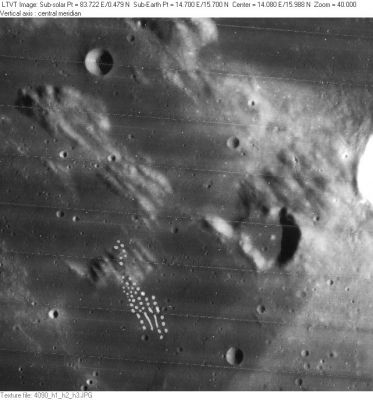Imbrium Sculpture
Contents
Imbrium Sculpture
(informal geologic name)| Lat: --, Long: --, Diameter: --km, Rukl: (surrounds Mare Imbrium) |
LO-IV-090H The fluted hills in this area just west of Menelaus (whose sunlit west rim interrupts the right margin) are an example of the Imbrium Sculpture. They have been raked in a direction radial to the center of Mare Imbrium. The shadowed crater to the right of center is Daubrée. Two of Menelaus's satellites are also visible: 7-km Menelaus A in the upper right and 4-km Menelaus C near the bottom. The dark region in the upper right is a small part of the floor of Mare Serenitatis, while the similarly-dark regions to the left and bottom are regarded as parts of Lacus Gaudii and Lacus Hiemalis.
Images
Maps
Description
Additional Information
- Many valley-like (or "groove"-like) depressions in the neighbourhood of the Ptolemaeus-Alphonsus-Arzachel-Albategnius group were formed during the impact which created the Imbrium basin. One of those valleys runs at the western rim of nearby crater Gyldén. Another one runs at the south-southeastern part of Parrot. A survey of all these radial "grooves" and their observability through all sorts of telescopes is needed!
- Other examples of the Imbrium radial sculpture are the hills Fra Mauro Eta and Zeta (northeast of Fra Mauro). Fra Mauro Eta is literally pointing like an arrow toward the impact location of the Imbrium basin.
- The environs of Ukert are "heavily" occupied by radial surface formations, all "pointing" toward the location of the Imbrium basin's centre.
- Research: Danny Caes.
- Gilbert's 1893 sketch of the Imbrium Sculpture (based on 18 nights of observations) can be found on page 277 of his monograph.
- Hartmann (1963) concluded that gouging by flying fragments could not explain the "sculptures" and suggested they were caused instead by radial fractures.
- Head (1976) compares the two then prevailing theories of the origin of the sculpture (erosion by and deposition of ejecta versus faulting along fractures created by the impact) and comes down on the side of the "sedimentary" hypothesis (erosion by and deposition of ejecta).
Nomenclature
- The term Imbrium Sculpture was introduced by the geologist G. K. Gilbert (1893), to whom it, and other similar sculptures, presented clear evidence of the impact origin of the lunar basins.
- The valley running near and at the western rim of Gyldén, which is part of the Imbrium radial sculpture, is unofficially called Vallis Gyldén by D.Caes.
- The valley (or rather "groove") running at the south-southeastern part of Parrot (also part of the Imbrium radial sculpture) is unofficially called Vallis Parrot by D.Caes.
- Note: It would be a most interesting project to give official (or unofficial) names to all the radial valley-like (or "groove"-like) depressions and chains of craters related to the Imbrium radial sculpture. The start of such a project is online in the lower half of the page Lunar Valleys.
LPOD Articles
Radiating Linears, A Long Line in a Clutter of Magnificence
Bibliography
- Schultz, P. H. and Crawford, D. A. (2016). Origin and implications of non-radial Imbrium Sculpture on the Moon – Nature, Volume: 535, Pages: 391–394. DOI: doi:10.1038/nature18278. Date published: (21 July 2016).
- Apollo Over the Moon, Chapter 3: The Terrae (Part 2), Figures 48 and 49 (Imbrium sculpture near Ptolemaeus and Albategnius).
- Gilbert, G. K. 1893. The Moon's face: a study of the origin of its features Bull. Phil. Soc. Wash. 12, 241.
- Hartmann, W. K. 1963. Radial Structures Surrounding Lunar Basins, I:The Imbium System . Comm. LPL 2(24), 1 -16
- Head, J. W. 1976. Evidence for the sedimentary origin of Imbrium sculpture and lunar basin radial texture. The Moon, vol. 15, June-July 1976, p. 445-462.
